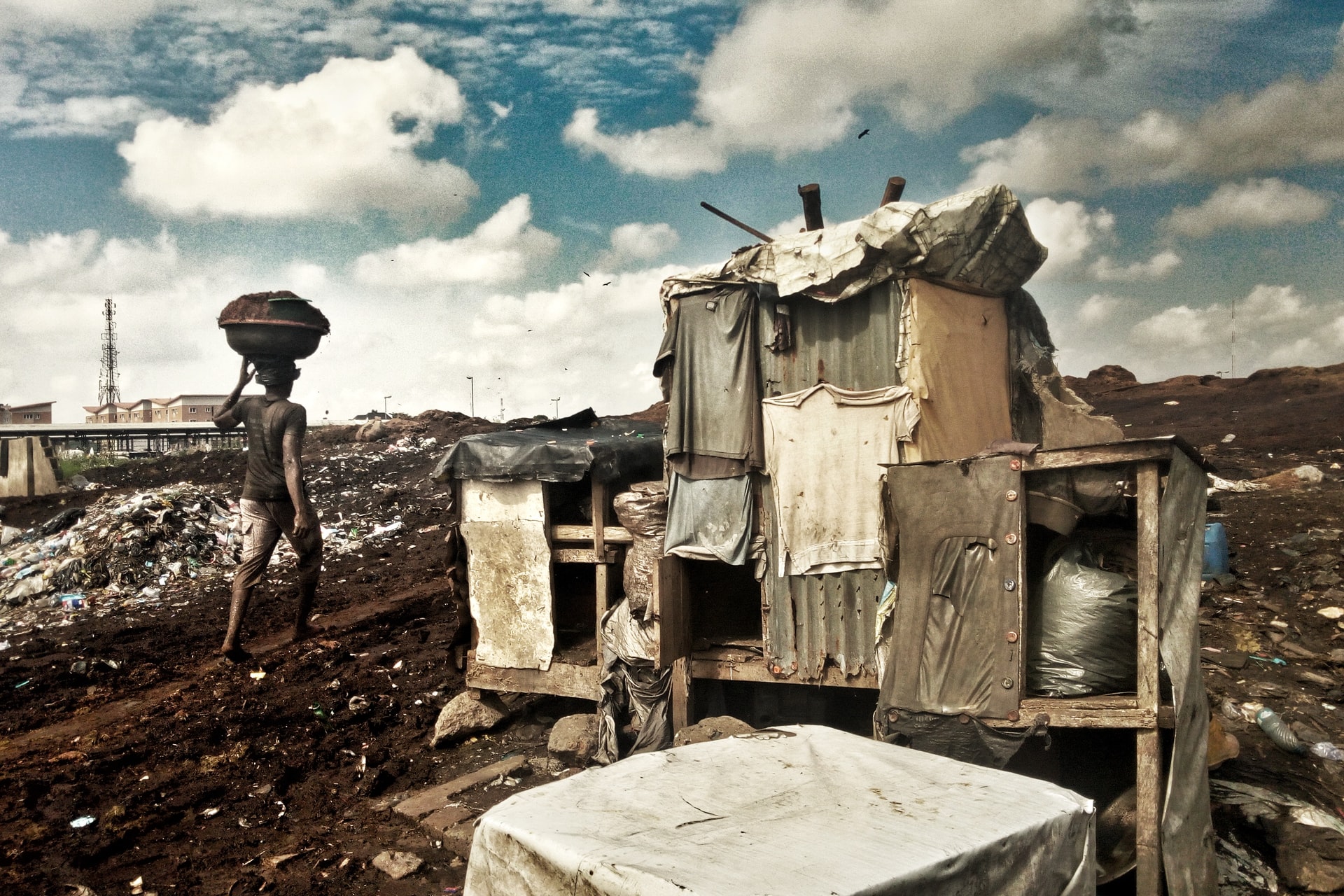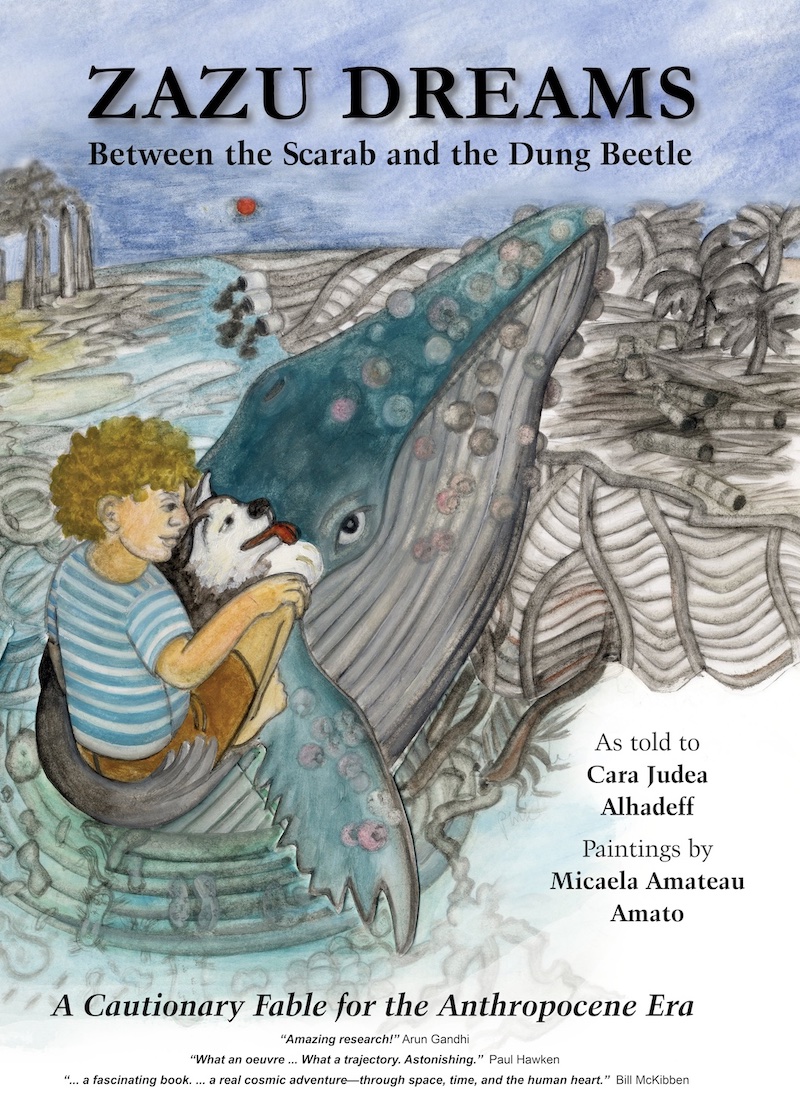
Covid, climate, and ‘dual metabolic rupture’
Editor’s note: While it’s true that “it is the profit machine that is polluting our atmosphere, warming our planet, and destroying our ecosystems”, the real root of human destructiveness lies further back in history, when groups of people started agriculture, building cities and forming human supremist ideologies that disconnected human cultures from all other living beings.
This article originally appeared in The Ecologist.
Featured image: “Unless” by Nell Parker
We thought climate catastrophe the main danger. Now we know there is another. A double-whammy ecological crisis threatens collapse into dystopian chaos.
“Pathogens, a great and terrible global threat to human and many a non-human alike, [are] as much a Sword of Damocles hovering above civilisation as climate change.”
Evolutionary epidemiologist Rob Wallace wrote this in 2015. But he and many colleagues have been issuing increasingly urgent warnings since the 1990s that globalised agribusiness is breeding and spreading new, deadly, fast-transmission viruses.
The urgency around pandemics began to ramp up around the same time calls for climate action became mainstream. Many of us have been focused on the climate emergency – and nothing here should be taken to imply we were wrong – but the last year has taught a sharp lesson: deadly pathogens pose an equally menacing threat to human civilisation.
Catastrophe
Since the first United Nations COP conference on global warming in 1995, the climate emergency has got much worse. Carbon emissions have accelerated from 26 billion tonnes in 1995 to 37 billion tonnes in 2018. Atmospheric concentrations have risen from 350ppm in 1990 to 410ppm today. Half the increase in average global temperatures since the Industrial Revolution has occurred since 1995. The average volume of Arctic sea-ice has roughly halved in the last 40 years. Whatever the metric, the same story.
The effects are all around us. More frequent and more intense heat-waves are causing increases in wildfires, droughts, and desertification. Rising and warming seas are causing heavier rainfall, more serious flooding, more frequent mega-storms, and the inundation of coastal areas. These changes are driving the world’s sixth mass extinction, with species loss running at 1,000 times the normal rate. Climate change is destroying livelihoods, increasing disease, displacing people.
We stand on the brink of critical tipping-points when incremental shifts lead to sudden and irreversible lurches in the Earth’s ecosystem. Among the potential tipping-points are: abrupt collapse of the West Antarctic ice-sheet; abrupt collapse of the East Antarctic ice-sheet; abrupt collapse of the Greenland ice-sheet; thawing of Arctic permafrost and release of methane gas; rapid deforestation of the Amazon; and failure of the Atlantic Gulf Stream. Some scientists fear a ‘global cascade’ of interacting tipping-points.
The failure of the global political elite is systemic. It is not that we do not know what to do. It is not that the wrong policies have been adopted. It is that the economic and geopolitical system – the current world order – cannot deliver the radical action necessary.
The OECD (Organisation for Economic Co-operation and Development), representing the world’s leading industrial economies, considered the pre-pandemic global growth rate of three percent to have been too low. Yet such annual growth rate means a doubling in the size of the world economy every quarter century.
The fossil-fuel corporations plan to extract twice the amount of coal, oil, and gas between now and 2030 than can be burned if we are to restrict global temperature rise to the 1.5ºC ‘aim’ of the Paris Agreement.
This ‘aim’ is not ambitious enough: most climate scientists predict severe damage to the Earth’s eco-system with this level of warming. But even this ‘aim’ falls well below the ‘pledges’ of the COP participants, which, even if implemented, are expected to result in a disastrous 3ºC of global warming. Many leading scientists think we are heading for at least 4ºC of global warming.
Metabolic
The term ‘metabolic rift’ has been used by some radical commentators, like John Bellamy Foster, to describe what is happening. I prefer ‘rupture’ because it better captures the violence of a corporate capitalist system that is out of control and tearing apart human societies and natural ecosystems.
Metabolism is a scientific word to do with how chemical changes reconfigure energy and sustain life. All of us need to get science-wise, to understand what is happening to our planet, to get a handle on what I am calling the ‘Dual Metabolic Rupture’.
Humans are part of Nature. On the one hand, we are animals with material needs and organic form. On the other, our actions impact upon the rest of Nature, sometimes degrading it, sometimes remodelling it, always having an effect.
All the products of human labour are therefore part of Nature. Everything we do to provide ourselves with a livelihood involves drawing upon the resources of Nature and refashioning them into new forms.
These processes are not reversible, but they may be repeatable. If a glacier melts because the temperature rises, the water of which it is formed flows away. If a new glacier forms in the same place when the temperature falls again, it must be comprised of another body of water. In Nature, as in Society, everything is process and motion.
The energy involved in natural processes is a constant: it can be endlessly recycled, but it cannot be destroyed, so whatever you do, it will still be there in one form or another. This is one of the basic laws of physics (known as ‘the First Law of Thermodynamics’).
It follows that human beings may interact with Nature in ways that are ‘renewable’ or ‘sustainable’ – where energy is recycled in essentially repetitive ways – or in other ways that cause a metabolic ‘rupture’ or ‘rift’ – where energy is reconstituted as a destructive force.
Let us take two contrasting examples. A hoe-cultivator who harvests a garden plot of cassava, feeds the tubers and leaves to her pigs, and then lets them roam to manure the plot, is engaged in a recycling of energy that is ecologically sustainable.
Corporations that extract oil, refine it into petroleum, and then sell it to other corporations to burn in jet engines are doing something quite different: theirs is not a renewable process, but a release of carbon waste into the atmosphere and a permanent remodelling of the Earth’s metabolism.
The basic rhythms of pre-capitalist societies were determined by the cycle of the seasons. But capitalism is a system of competitive capital accumulation hard-wired by the profit motive for exponential growth.
The former were always essentially local or regional, so that what happened in one place had limited impact in others: the latter is now a fully globalised system which has the whole of humanity and the entire global environment in its grasp.
In the end, it is simple: it is the profit machine that is polluting our atmosphere, warming our planet, and destroying our ecosystems.
But that’s not all it’s doing.
Anthropocene
The system – let’s define it: globalised, financialised monopoly-capitalism – is blind to everything except the balance sheet, the bottom line, the annual profit.
The lords of capital have turned the Earth – its lands, its waters, its minerals – into private property. They have commodified its ecosystems and appropriated its bounty. And in their wake they spew waste and pollution that become ‘externalities’ for which others must pay.
Where to start? The catalogue of devastation is so long. Forests are cut down, wetlands drained, soils eroded. Water extraction turns farmland into desert. Chemicals are dumped in oceans, lakes, and rivers. Toxins leak into groundwater. Fertilisers, herbicides, and pesticides contaminate food supplies.
Landfills overflow with synthetic waste. Nuclear power plants melt down and fill air, land, and sea with carcinogenic particles. A chemical smog fills urban streets and poisons children on the way to school. Plastic waste degrades into trillions of microscopic specks that infect every living organism.
Now, from deep within this mayhem, a second titan of destruction has emerged to stand alongside the mega-threat of climate change: pandemic disease.
Both titans are formed of trillions of tiny particles. Climate change is driven by atoms of carbon dioxide – tiny particles of dead organic matter pumped into the atmosphere when fossil fuels are burned. Pandemic disease is driven by microscopic parasites – tiny particles of living organic matter that breed, spread, and evolve by infecting the bodies of animals.
But that does not mean Covid-19 is a natural disaster, any more than carbon pollution. Nor is it an Act of God or a ‘Chinese’ conspiracy. Covid is a human-made catastrophe, as much an artefact of the Anthropocene as global warming.
I agree with colleagues who argue that the Holocene is over. This is the term we have used to describe the last 11,700 years of Earth history, since the end of the last Ice Age – until now. From around 1950, and at an accelerating rate since, the Earth system has been undergoing radical change as a result of human action. We have entered a new geological era in which Anthropos (the Greek word for human) is the primary agent of change. The primary form of change is metabolic rupture.
Covid-19 is a pandemic disease of the Anthropocene’s metabolic rupture.
Pandemic
Mainstream commentary on the pandemic is refracted through a neoliberal prism. Attention focuses on immediate problems and proximate causes. I am not talking about serial liars like Johnson and his third-rate cabinet of public-school toffs and corporate spivs. I am talking about more honest commentators keen to see through the spin and smoke-cloud that shields a corrupt and incompetent political class.
But it is not enough to expose the negligence, crony capitalism, and eugenicist experiments of the Tories – the failure of test-and-trace, the lack of PPE, the locking down too late and lifting too early, the discharging of the sick into care homes, the spreading of the virus in schools and universities, and so much more.
It is necessary, but not enough. The narcissistic charlatan who runs the government might eventually be thrown out. But so what? There is a much bigger issue: the metabolic rupture between corporate agribusiness and natural ecology that has created the multiple global incubators of new deadly diseases.
In 1950, a large proportion of the Earth’s people were peasant farmers, predominantly in the Global South. As recently as 1980, only 20 percent of China’s population was urban; the proportion today is 60 percent. A growing number of those who remain in the villages, moreover, have been transformed into wage-labourers.
The advance of corporate agribusiness is relentless. As I write, the Hindu-chauvinist regime of Narendra Modi is facing an uprising of small farmers whose livelihoods are threatened with destruction by neoliberal ‘reform’. So desperate is their plight that record numbers of India’s small farmers have been committing suicide.
As well as destroying traditional communities, agribusiness is expanding into the wilderness, uprooting forests, destroying the diversity and balance of natural ecologies, and replacing them with vast monocultures. Half the habitable surface of the Earth is now devoted to agriculture, with millions of acres added every year.
Much of the crop-land produces animal feed for the hundreds of millions of cattle, sheep, pigs, and poultry being fast-fattened for the global supply-chains that loop the world. The mega-complexes of Big Farm’s industrialised animal production are laced around and between the mega-slums of the Global South’s ever-growing urban proletariat.
This is what links a remote bat-cave in hinterland China with the morgues of New York and London. Big Farm batters down natural ecology, destroying diversity and firebreaks. Viruses that would have burnt themselves out in the forest for lack of carriers adapt to a new ecology of monoculture, animal factories, and slum cities; they mutate and evolve and then achieve fast-track transmission through mass concentrations of the same species.
The global supply-chains of giant transnationals with operations in half a dozen countries and markets in a thousand cities do the rest.
Once a new variant is established, it replicates by the trillion at hyper-speed, throwing up chance mutations, testing new ways of spreading. The disease becomes endemic and chronic – embedded in human society – and continues to evolve, waging a relentless life-or-death struggle against lockdowns and vaccines by constant shape-sifting in its efforts to breach the defences.
Warning
This – the pandemic diseases created and spread by corporate agribusiness – is then layered over societies mired in poverty and stripped of public health-provision by neoliberal ‘structural adjustment programmes’, privatisation, and austerity cuts.
The epidemiologists have been warning of the dangers for a quarter of a century. There have been dozens of outbreaks of different viruses or variants, all involving a similar basic mechanism: the introduction of a wild-animal virus, its transmission and evolution through factory-farm complexes, a jump from animal to human, often in mutant form, and rapid global spread through transnational supply-chains.
The warning, endlessly repeated, was that, sooner or later, one of the new diseases created by neoliberal capitalism would take off. But there is no profit in pandemic precaution.
The improvised plague cemeteries; the body-bags in the morgues; the patients breathing through ventilators; the traumatised and exhausted health workers; the everyday folk left grieving; the jobs lost, businesses gone bust, homes lost to the bailiffs; the swelling toll of mental breakdowns; the loneliness, the shrivelled lives, the sense of desolation and despair: all this and more amount to so many ‘externalities’ for the profit machine.
The machine carries on. It is being recalibrated. Some businesses may be shutting down, but big capital is highly mobile. The money moves at click-key speed. It flows from a place where profits are down to another where they are up.
America’s 660 billionaires, for example, are doing just fine right now. Since March last year, their wealth has increased 39 percent, from just under $3 trillion to more than $4 trillion today. It is the rest of us, of course, who pay for the system’s ‘externalities’.
Those ‘externalities’ now take the form of a Dual Metabolic Rupture between humanity and the planet, as industrial pollution destroys our ecosystem, and agribusiness generates wave after wave of killer pathogen. We are the inhabitants of a new geological age – the Anthropocene – in which globalised, financialised monopoly-capitalism has become an existential threat to life on Earth.
What happens next depends on what we do. The imperative to get active has never been greater.
Neil Faulkner is the author of A Radical History of the World and co-author of System Crash: an activist guide to making revolution.






















